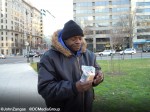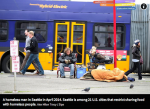
By Emma Whitford in Occupy The Bronx – Dozens of homeless New Yorkers and advocates rallied on the steps of city hall this afternoon to single out and condemn the NY Post’s recurring portrayal of the homeless as dehumanized, quality-of-life case studies, as well as the Sergeants Benevolent Association’s recent public solicitation of photographs ofhomeless people engaging in “quality-of-life offenses of every type.” “We’re here today because we’re disgusted by the treatment of homeless people in our city,” said Alyssa Aguilera, the Political Director for Vocal New York. “We’re tired of the criminalization and stigmatization of homeless people who are struggling, and need housing, and who need social services. Instead they are being targeted by the police.” According to the SBA, civilian documentation of the homeless is a valid response to those who exercise their right to surveil the NYPD.

By Maria Sanchez Diez in Quartz – London has taken to placing small, sharp spikes to discourage homeless people from sleeping in public areas. But a group of activists has found a creative way to subvert the tactic: transforming them into cozy bedrooms, complete with tiny libraries. The collective, called Space, Not Spikes, wants to make a point: the hostile metal studs and other devices purposely designed to drive people away are not okay. “We’re told where we can walk, where we can sit, where we are welcome but only if we spend money,” says the group’s manifiesto. The group chose the spiked nook in Curtain Road, in the eastern neighborhood of Shoreditch, and glued on a mattress and the small bookshelf, with some available books for the public. Leah Borromeo, one of the activists involved in the protest, explained to Quartz that the germ of the idea came when the group overheard a couple of women coming out of a store, laying their shopping bags over the spikes on the ledge so they could sit there.

These sacred luxury consumer temples (where the water tanks are always full), lowered their doors before the the march that brought together 15 thousand men, women and children – a significant part dressing in MTST (Workers Homeless Movement)’s t-shirts – in addition to other left wing organizations protesting on Thursday (26/02) against the water crisis in São Paulo. It was the first major public protest on the issue and involved people like the seamstress Maria Francisca da Conceição, 69, who walked, wearing her flip-flops, the 6300 meters that separate Largo da Batata, in Pinheiros neighborhood, and the Bandeirantes Palace in Morumbi, where is the official residence of the governor Geraldo Alckmin (PSDB) is located.Maria Francisca has been a resident of an MTST occupation in Numa Pompilius, in the extreme east of the city of São Paulo, since early 2014, when she joined the homeless movement.

The Tucson City Council voted this week to relocate homeless people who have been living in a downtown park for a year and a half. The camp, called “Safe Park” by its occupants, includes the sidewalk along Veinte de Agosto Park at Church Avenue and Congress Street. A self-described camp leader said the group’s presence protests the criminalization of homelessness in Tucson. Jon McLane, Safe Park resident who refers to himself as its director, said that insufficient community-provided resources, yet being cited for public urination or breaking curfew in a park is how the homeless are criminalized. The City Council’s decision allows them to select one or multiple unused city properties to replace Veinte de Agosto Park, said Steve Kozachik, a city councilman who represents part of downtown.

The campaign comes amid a rise in the nationwide homeless population, and in laws targeting them, since the 2008 recession. Advocates say these laws are aimed at removing those deemed undesirable from public spaces, and that they subject homeless people to police harassment or arrest for carrying out activities that everyone must do — but only some have to do in public areas. The number of laws used to target the homeless increased sharply in the 1980s. One recent study in California found that these municipal laws rose along with the homeless population — there was a spike in the 1980s when federal funding for affordable housing was slashed and again after the 2008 recession. Criminalization, advocates say, can make it more difficult to reduce homelessness.

Byron Hawkins speaks of his most difficult challenge on the street is not living on it but “dealing with fools.” Assaults and fights between the homeless are common as are disputes over choice spots. “I’ve seen more stuff happen here on the streets than the average man.” He speaks of his worst experience in prison and why he knows he’ll never go back. His mother died while he was there and the experience broke his spirit. “They strapped me to a chair in a jacket with my arms pulled around me.” He couldn’t accept that the prison warden would not allow him go to bury his mom, and how hard it was he would never see her again. The prison psychologist sedated him with a shot to calm and put him to sleep. It took seven guards to hold him down. “They kept me there for three days until I broke.” “They didn’t let me out even to go to the bathroom-you s— and p— in this chair until you calm down.” He tells of it as the worst experience of his life.

Arnold Abbott, 90, has been feeding homeless people in Fort Lauderdale, Fla., for more than two decades. He has said that this is his life’s mission. He even started a culinary program that trains homeless people in hopes of getting them jobs at local kitchens. But on Oct. 21, the city of Fort Lauderdale made his generosity a crime when they passed an ordinance that placed strict restrictions on sharing food. Last weekend, Abbott was cited for breaking the new ordinance. He faces up to 60 days in jail and a $500 fine. “One of the police officers said, ‘Drop that plate right now,’ as if I were carrying a weapon,” Abbott told the Associated Press. But that’s not stopping Abbott. On Wednesday evening, he returned to the public beach where he cooks up food and was met with cheering crowd of nearly 100 homeless people and volunteers.

Uniformed police shut down an effort to provide lunch to scores of homeless in Stranahan Park on Sunday, enforcing a law passed recently that puts new limits on outdoor feeding sites. At least three people were cited for violating the new ordinance, including two members of the clergy and a 90-year-old advocate who has handed out food to the homeless for more than 20 years. Arnold Abbott, who heads the group Love Thy Neighbor, said he had served only three or four of about 300 meals he had prepared when police ordered him to stop. Abbott, the Rev. Mark Sims, of St. Mary Magdalene Episcopal Church in Coral Springs, and the Rev. Dwayne Black, pastor of The Sanctuary Church in Fort Lauderdale, were each cited for willfully violating a city ordinance. Police issued them notices to appear in court, where they could be asked to explain their actions.

In the United States, 21 cities have restricted sharing food with homeless people through legislation or community pressure since January 2013, and about 10 other cities are in the process of doing so, the National Coalition for the Homeless (NCH) said in a report released Monday. “One of the most narrow-minded ideas when it comes to homelessness and food-sharing is that sharing food with people in need enables them to remain homeless,” the report said. The report was released a day before Fort Lauderdale, Florida, was set to vote “on the city’s third ordinance this year that will target the life-sustaining activities of people experiencing homelessness,” the NCH said in a news release.

Housing the homeless of Baltimore in the city’s vacant rowhouses is being floated again by local affordable housing activists whose idea forms the core of an article in the current Atlantic. Their idea is “to create a community land trust – a non-profit that will hold the title to the land in order to make it permanently affordable.” according totoday’s piece by Alana Semuels. “Structures on the land can be bought and sold, but the trust owns the land forever,” she writes about the proposal by Housing Is A Human Right Roundtable, a coalition of labor activists and homeless people affiliated with the United Workers. “A community land trust essentially takes the ‘market’ part out of the housing market, allowing people to buy homes but restricting their resale value in order to make them affordable for the next buyer.”

Here’s How Vancouver Responded to London’s “Anti-Homeless Spikes”: A Vancouver charity, RainCity Housing, is converting city benches into pop-up shelters for homeless people. And by giving homeless people in this rainy city some dry coverage and a place to rest, RainCity is putting London’s anti-homeless spikes to shame. The company specializes in accommodation and support services for the homeless in Vancouver. They used designs that feature welcoming slogans on the bench backboard. During the daytime, the benches are places to wait for a bus or sit. At night, they convert into usable shelters where the backboard lifts up to provide shelter. The daytime city bench uses UV rays from sunlight, so the bench reads, “This is a bench.” Then at night, glow-in-the-dark wording appears, saying, “This is a bedroom,” and drives people to the RainCity website. Another bench installation reads, “Find shelter here,” and when the bench’s back support is raised up, it says, “Find a home here,” providing the address of a RainCity shelter.

As if their city’s failure to provide them with shelter weren’t bad enough, homeless people in London faced further acts of dehumanization recently when a property developer and supermarket erected spikes meant to deter them from sleeping there. A few weeks ago, spikes were assembled outside a grocery store called Tesco as well as in front of the entrance to luxury flats. “There was a homeless man asleep there about six weeks ago,” an anonymous resident told the Telegraph. “Then about two weeks ago all of a sudden studs were put up outside. I presume it is to deter homeless people from sleeping there.” In response to the inhumane construction, activists called the London Black Revolutionaries took to pouring concrete over the spikes outside of Tesco, leaving signs behind that read “Homes Not Spikes.”

The East Bay city of Albany, California, a relatively small town (approximately 19,000 residents) – just north of the former bastion of leftist politics and culture, Berkeley – this past Thursday cleared the last homeless residents from public land by charging them with “suspicion of illegal lodging.” According to the Monday June 2 The Daily Californian: Police arrested Bulb [the name of the publicly owned landfill in the bay] residents Amber Whitson and Philip Lewis, along with their friend Erik Eisenberg, on suspicion of illegal lodging. The city began enforcing a no-camping ordinance in October in an effort to relocate the homeless population so that the Bulb can be turned into a state park. Local law firms then filed a lawsuit against the city on behalf of the residents, which ended in an April settlement that gave residents $3,000 each as long as they agreed to leave the Bulb by April 25 and stay away from the area for one year.
|
|













